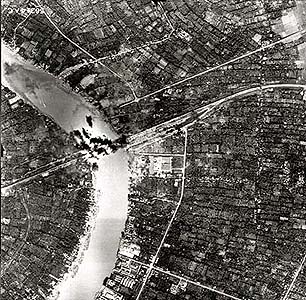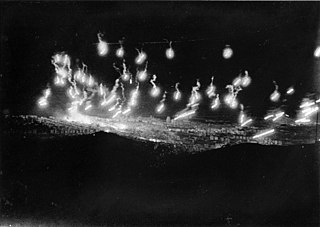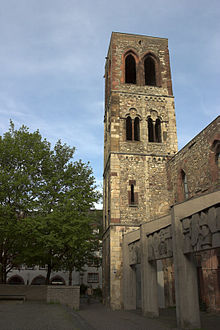
Firebombing is a bombing technique designed to damage a target, generally an urban area, through the use of fire, caused by incendiary devices, rather than from the blast effect of large bombs.
The Baedeker Blitz or Baedeker raids were a series of aerial attacks in April and May 1942 by the German Luftwaffe on English cities during the Second World War. The name derives from Baedeker, a series of German tourist guide books, including detailed maps, which were used to select targets for bombing.

Bischofsheim is a municipality in Groß-Gerau district in Hesse, Germany with a population of more than 13,000.

World War II (1939–1945) involved sustained strategic bombing of railways, harbours, cities, workers' and civilian housing, and industrial districts in enemy territory. Strategic bombing as a military strategy is distinct both from close air support of ground forces and from tactical air power. During World War II, many military strategists of air power believed that air forces could win major victories by attacking industrial and political infrastructure, rather than purely military targets. Strategic bombing often involved bombing areas inhabited by civilians, and some campaigns were deliberately designed to target civilian populations in order to terrorize them and disrupt their usual activities. International law at the outset of World War II did not specifically forbid the aerial bombardment of cities – despite the prior occurrence of such bombing during World War I (1914–1918), the Spanish Civil War (1936–1939), and the Second Sino-Japanese War (1937–1945).
Big Week or Operation Argument was a sequence of raids by the United States Army Air Forces and RAF Bomber Command from 20 to 25 February 1944, as part of the European strategic bombing campaign against Nazi Germany. The planners intended to attack the German aircraft industry to lure the Luftwaffe into a decisive battle where the Luftwaffe could be damaged so badly that the Allies would achieve air superiority which would ensure success of the invasion of continental Europe.

The German city of Cologne was bombed in 262 separate air raids by the Allies during World War II, all by the Royal Air Force (RAF). A total of 34,711 long tons of bombs were dropped on the city by the RAF. 20,000 people died during the war in Cologne due to aerial bombardments.

The double city of Ginsheim-Gustavsburg in the northwest of the Groß-Gerau district in the German state of Hesse, has about 16,000 inhabitants. It is part of what is called the Rhine-Main region in Germany which has the city of Frankfurt am Main at its centre.
The bombing of Romania in World War II comprised two series of events: until August 1944, Allied operations, and, following the overthrow of Ion Antonescu's dictatorship, operations by Nazi Germany.
The bombing of Stuttgart in World War II was a series of 53 air raids that formed part of the strategic air offensive of the Allies against Germany. The first bombing occurred on August 25, 1940, and resulted in the destruction of 17 buildings. The city was repeatedly attacked over the next four and one-half years by both the RAF and the 8th Air Force as it had significant industrial capacity and several military bases, and was also a center of rail transportation in southwestern Germany. Stuttgart endured 18 large-scale attacks by the Royal Air Force (RAF) during the war, during which 21,016 long tons (21,353 t) of bombs were dropped on the city, but the RAF concluded that its attacks against Stuttgart were not as effective as they could have been:
Stuttgart's experience was not as severe as other German cities. Its location, spread out in a series of deep valleys, had consistently frustrated the Pathfinders and the shelters dug into the sides of the surrounding hills had saved many lives.

The bombing of Königsberg was a series of attacks made on the city of Königsberg in East Prussia during World War II. The Soviet Air Force had made several raids on the city since 1941. Extensive attacks carried out by RAF Bomber Command destroyed most of the city's historic quarters in the summer of 1944. Königsberg was also heavily bombed during the Battle of Königsberg, in the final weeks of the war.
The German city of Mannheim in the state of Baden-Württemberg saw bombing during World War II from December 1940 until the end of the war. Mannheim saw over 150 air raids.

During World War II, the city of Lübeck was the first German city to be attacked in substantial numbers by the Royal Air Force. The attack on the night of 28 March 1942 created a firestorm that caused severe damage to the historic centre, with bombs destroying three of the main churches and large parts of the built-up area. It led to the retaliatory "Baedeker" raids on historic British cities.

The Defence of the Reich is the name given to the strategic defensive aerial campaign fought by the Luftwaffe air arm of the combined Wehrmacht of Nazi Germany over German-occupied Europe and Nazi Germany during World War II. Its aim was to prevent the destruction of German civilians, military and civil industries by the Western Allies. The day and night air battles over Germany during the war involved thousands of aircraft, units and aerial engagements to counter the Allied strategic bombing campaign. The campaign was one of the longest in the history of aerial warfare and with the Battle of the Atlantic and the Allied Blockade of Germany was the longest of the war. The Luftwaffe fighter force defended the airspace of German-occupied territory against attack, first by RAF Bomber Command and then against the United States Army Air Forces (USAAF) in the Combined Bomber Offensive.

The Bombing of Bremen in World War II by the British Royal Air Force (RAF) and US Eighth Air Force involved both indiscriminate "area bombing" and, as capacity improved, more targeted raids upon the city's military-industrial facilities. These included, the shipyards of Vulkan, AG Weser and Atlas Werke, the Valentin submarine pens, oil refineries and the aircraft works of Focke-Wolf.

The city of Bangkok, Thailand was bombed by the Allies on numerous occasions during World War II. It was also the target for the first combat mission by Boeing B-29 Superfortresses in June 1944.

The bombing of Cagliari was a series of attacks by the United States Army Air Force and the Royal Air Force on the Italian city of Cagliari, the regional capital of Sardinia, during World War II. The raids, aimed at destroying the port facilities and airfields of Cagliari, also resulted in the destruction of most of the city.

Owing to its importance as an industrial center, home to Fiat and several other industries engaged in war production, Turin, the regional capital of Piedmont, suffered over a hundred raids by the Allied air forces during World War II; the Piedmontese capital was thus among the most bombed cities in Northern Italy, suffering damage to about 40% of its housing stock, and over 2,000 victims among its population.

During World War II, Tuscany, the Italian port city of Livorno was repeatedly bombed by the Allied air forces, suffering about a hundred raids altogether, which resulted in it being among the most war-damaged cities in Italy.

Owing to the importance of its port and industries, the Italian port city of Genoa, the regional capital and largest city of Liguria, was heavily bombarded by both Allied air and naval forces during Second World War, suffering heavy damage.















